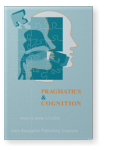Vol. 26:2/3 (2019) ► pp.215–238
Poly-procedural meaning and rhetoric
The case of afu in Modern Greek
The current paper aims to explore the meaning of one of the most elusive discourse markers in Modern Greek rhetorical discourse: afu. To address the challenge of a thorough and parsimonious account, the relevance-theoretic model of meaning analysis is deployed. The analysis undertaken ultimately reveals that the marker at hand encodes procedural meaning in standard relevance-theoretic terms. However, unlike traditional relevance-theoretic approaches linking a marker to a single procedural function, the current one proposes that afu encodes a poly-procedural constraint on the implicated content of the utterance containing the marker. Moreover, it is argued that this poly-procedural constraint is rhetorically exploited by the speaker in the interest of convincing argumentation.
Article outline
- 1.Introduction
- 2.Rhetorical afu and its co-textual varieties
- 3.
Afu: Some preliminary remarks
- 3.1Epistemic and backgrounding functions
- 4.Relevance theory
- 4.1Mutual cognitive environment
- 4.2Discourse markers and procedural meaning
- 5.Rhetorical afu: A procedural marker
- 5.1 Afu’s dual constraint on implicitly communicated content
- 5.2The rhetorical use of afu
- 5.3A parsimonious account of rhetorical afu
- 6.Conclusion
- Notes
-
References
